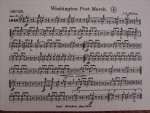Ghostin one
Senior Member
See the symbols above and below the repeat in the beginning of the ninth bar (first bar in the second line, after the eight bar intro... similar to brackets. They occur at other repeats, too.
Anyone recognize these? What are they and how do they work?
Other Sousa songs in this book use these symbols, but I figured this was the most familiar of the songs, so I chose this one to post.
Anyone recognize these? What are they and how do they work?
Other Sousa songs in this book use these symbols, but I figured this was the most familiar of the songs, so I chose this one to post.


